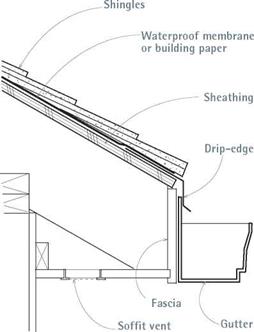GUTTERS AND DOWNSPOUTS
Eyeball the eaves trim. Is it intact or splitting? Do you see stains or discoloration? Water damage along eaves is usually caused by clogged gutters or missing drip-edge flashing on the roof and, less often, by roof leaks.
You’ll need to replace metal gutters that have rusted through or that leak widely. But this a moderate expense, unless you replace them with copper gutters.
If the deteriorated gutters are wood, they will usually be nailed directly to fascia trim or, less often, built into a cornice. By the time they fail, they may have allowed a lot of rot behind them. Probe to see how much. Wood gutters are the most expensive to replace, so consider alternatives.
Stained siding behind downspouts may have been caused by gutter seams that rusted through. Or if the downspouts and gutters are new, upper downspout sections may have been mistakenly slipped over lower ones, rather than into them.
![]()

![]()
 Any exterior weathering or deterioration may signal rot behind. To find out, use a pocketknife
Any exterior weathering or deterioration may signal rot behind. To find out, use a pocketknife
or a screwdriver to probe the trim along the eaves, siding-trim joints, discolored siding along the base of a house, and the perimeters of windows and doors. If there’s rot, a gentle pressure on the blade will be enough to penetrate damaged areas. But be respectful and discrete: Few owners would enjoy seeing their siding gouged with a knife.
If rainwater gushes over the gutter, either the downspout screen, the downspout itself, or the ground drainpipe is clogged. Aboveground clogs are easy to fix. Belowground clogs require either reaming tools or digging, still only moderate expenses. But if the drainpipe is clogged with tree roots, you’ll need to replace the underground pipe and seal its joints to prevent tree-root penetration.
Wood siding will deteriorate if it’s not well maintained, especially along south-facing walls, which get the most sun. A certain amount of weathering is normal.
Cracked and worn shingles or clapboards can be replaced, but if the deterioration is widespread, you’ll need to re-side the whole wall.
If you see widespread vertical black-brown stains on siding that’s otherwise in good shape, installers likely failed to use galvanized or corrosion-resistant nails. Fixing the problem may mean sinking, filling, and priming the nail heads—a tedious undertaking.
Siding that’s discolored along the base could be caused by any of several factors: (1) bottom siding that’s too close to the ground, (2) nearby plants keeping the siding surface damp,
(3) splashback from roof runoff, or (4) a badly positioned lawn sprinkler. All are easy fixes themselves, but moisture may already have caused the underlying framing to rot.
Imitation wood siding that delaminates or sprouts fungus is probably an exterior hardboard that’s been discontinued because of class-action lawsuits. Replace the siding.
Chronically peeling paint on the exterior walls of bathrooms and kitchens is usually caused by excessive room moisture migrating outdoors. The remedy is usually to improve room ventilation—a moderate expense.
Stucco is strong and relatively maintenance free, but it will crack if the building shifts. (See "Tattletale Cracks,”on the facing page.)
Loose or bulging stucco has separated from the lath behind. This is a modest repair, unless the problem is widespread. If you see extensive patching, be suspicious.
Loose, crumbling stucco is common if the base of a wall is close to the soil or in contact with it. This is usually a modest repair cost.
Newer homes with rot in the walls may have incorrectly installed "synthetic stucco,” or EIFS; this is especially a problem in the Southeast. Have an EIFS specialist certify that the house is sound; this is a headache you don’t need.
Brick is strong but its joints may crack if the foundation moves, whether from settling, frost heave, or earth tremor.
If a brick veneer half-wall is pulling away from an exterior wall or if a full-story brick facade is bowing outward, the metal ties holding the brick to the wall sheathing may have rusted out. Repairs will be expensive. This condition may also signal water damage and foundation problems. Eroded mortar joints can be repointed with mortar if the bricks are sound.
Mortar joints that have step cracks above doors and windows are usually caused by rusting steel lintels. Support the bricks above the opening before replacing the lintel.
Vinyl or metal siding doesn’t require much maintenance and protects the structure if it’s properly installed. However, if there are gaps between sections or where siding abuts trim, suspect a sloppy installation and probe for rot behind.







Leave a reply